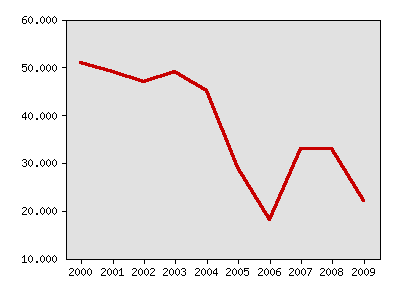Indicator 48: Counties with In-Migration


Rationale: Minnesotans value their freedom to choose where to live. Minnesotans in communities throughout the state also want their youth to be able to make a living without moving away. Migration is a good indicator of the relative attractiveness of an area.
About this indicator: Fewer counties are experiencing in-migration in the 2000s. The number of counties with net in-migration declined from 51 in 2000-2001 to 22 in 2008-2009. Minnesota has 87 counties.
The decline in the number of counties with net-migration reflects lower population growth in the state as a whole. Less statewide growth has translated into slower growth in most regions of Minnesota.
Net migration is calculated by subtracting natural increase (births minus deaths) from population change. Out-migration does not necessarily lead to population loss if there is sufficient natural increase to compensate.
Number of counties with net in-migration

| Year | Data |
|---|---|
| Number of counties with net in-migration, Minnesota State Demographic Center | |
| 2000 | 51 |
| 2001 | 49 |
| 2002 | 47 |
| 2003 | 49 |
| 2004 | 45 |
| 2005 | 29 |
| 2006 | 18 |
| 2007 | 33 |
| 2008 | 33 |
| 2009 | 22 |
For comparison: Between 1990 and 2000, 55 counties experienced net in-migration.
Sources:Annual data calculated by Minnesota State Demographic Center
Related 2002 Milestones indicator:
Local data:




